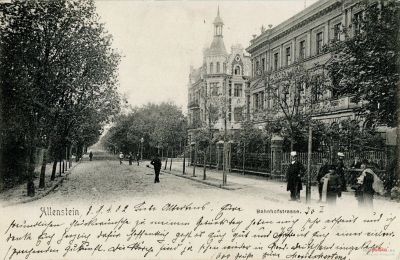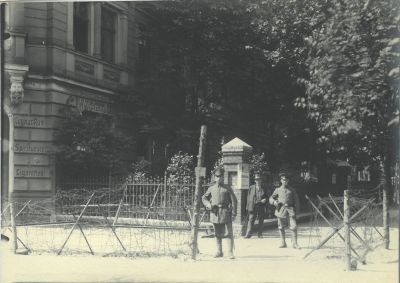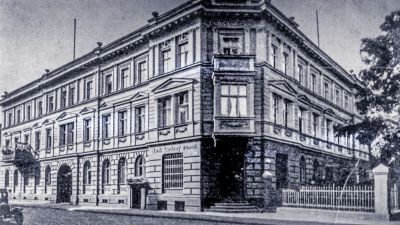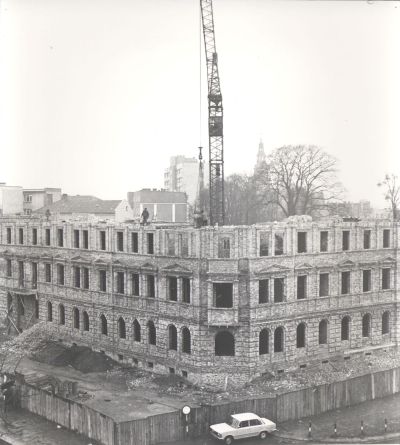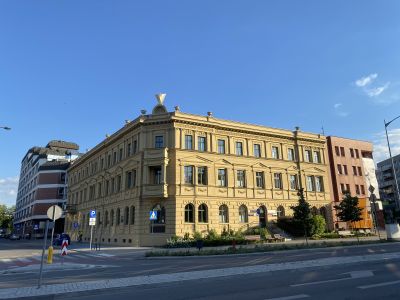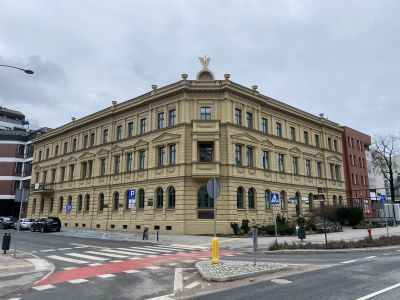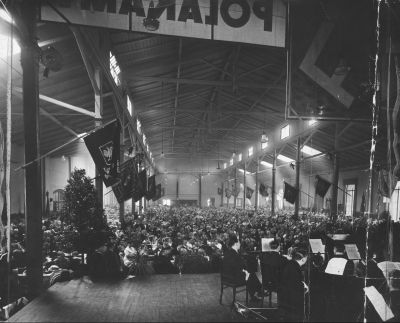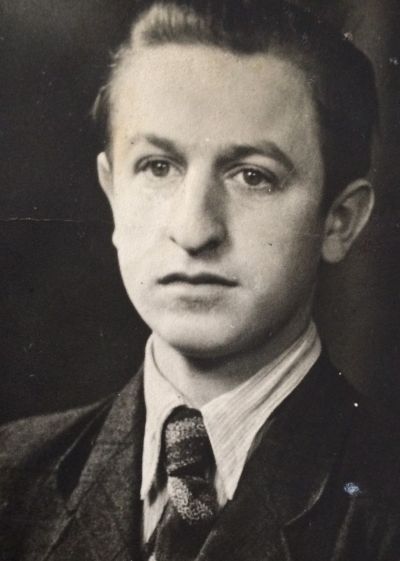Dom Polski in Allenstein / Olsztyn

Before the First World War, a series of restaurants and inns were housed in the impressive Gründerzeit building, the exterior of which has changed very little since it was built around 1885 by the entrepreneur Joachim Hosmann. In 1899, Hosmann sold the house to Otto Holzky, who opened a hotel called “Reichshof” there. In the years that followed, the building changed owner several times but the hotel, in which the Prussian General Field Marshall Albrecht of Prussia stayed the night, remained in operation, even though its name changed: In 1912, it was renamed “Central Hotel, before being changed back to “Reichshof” again a few years later.
The First World War and the enormous political, economic and social changes that went with it also manifested themselves in the garrison town, which until that time had been a quiet provincial town. The house in Bahnhofstraße was to become the focal point of German-Polish relationships, or rather the lack of them. In 1920, the building was bought by the authorities of the Second Republic of Poland that was created in 1918 and parts of the building were repurposed to become the headquarters of the Polish Plebiscite Committee. The hotel kept operating as an “international” hotel under the new owners.
On 22 June 1920, the Treaty of Versailles was adopted by the National Assembly of the newly founded Weimar Republic: According to the provisions of the Treaty, Poland – which had been divided between the German Reich, Austria-Hungary and Russia since 1795 – became an internationally recognised and independent republic to which the German Reich had to make territorial concessions. The Treaty of Versailles, which was perceived as a “dictatorial peace”, was rejected by all levels of German society. In May 1919, the left-wing politician, pacifist and anti-war protestor Hugo Haase from Olsztyn wrote:
“As an East Prussian, I would particularly like to point out the violation which has been wrought on the people of this province ... For almost 40 years, I, along with the residents of this territory that is now to be torn away from the German Reich, have never thought about a separation, never wished an association with another folk; it is simply pushed like a lifeless mass onto another state through an act of violence.”[1]
According to the treaty, referenda were supposed to be held in several border regions in order to establish the allegiance to the German Reich or its neighbours. In the province of Eastern Prussia, a referendum was established on 11 July 1920 for the southern Warmia and Masuria regions. At the beginning of 1920, British, French, Italian and Japanese (!) troops arrived in Olsztyn and took over the military command and the civilian administration. All those entitled to vote in the plebiscite had to have reached the age of 21 on 10 January 1920 and had to have been born in the voting district or had their place of residence there since 1 January 1905. People from Warmia and Masuria living outside the district were also entitled to vote. The Poles could not hope to have any great support in Masuria, but the outlook was somewhat better in the Olsztyn district. To ensure secure and fair elections, the town of Olsztyn became its own state for a while: The voting regions were under the control of two Allied Commissions made up of five members appointed by the most important allied and associated powers as representatives of the League of Nations. However, tensions had grown since the Allied Commission had arrived in the town. At the beginning of March, there was an altercation in the Polish Consulate, as the conservative German nationalist newspaper Ermländische Zeitung reported on 7 March 1920:
“Around midday, when the band of the British troops played in front of the government building in which the Allied Commission had its headquarters, a Polish flag was hoisted out of one of the windows of the Polish Consulate. As soon as it was visible, the people gathered before the Consulate; and also the people who had gathered in front of the government building to hear the concert hurried in the direction of Bahnhofstraße and joined the people in front of the Consulate. The German population now shouted: 'Lower the flag!' When nothing happened and the Consul General showed himself at the window, some of the men stormed on to the terrace of the Hotel Imperial, which was housed in the same building, tore the flag down amidst yells from the crowd and ripped it up. Then the crowd sang 'Deutschland, Deutschland über alles' and 'Heil dir im Siegerkranz'.”
The Allied Commission then removed the Mayor of Olsztyn, Georg Zülch, from office because he refused to apologise to the Polish Consulate. In the weeks leading up to the plebiscite, both sides increased their activities and the constituencies were flooded with posters and flyers, patriotic celebrations, concerts and rallies. The Polish activities were planned and coordinated from the house in Bahnhofstraße. At the same time, however, the Second Polish Republic was conducting a bloody war against the Soviet Union, so the support for the plebiscite had to take a back seat in the face of the war situation: In May 1920, the Red Army had started an offensive in the vicinity of Kiev, at the beginning of June the Polish troops were on the retreat. It did not look good for the Polish state. The closer the date for the vote got, the more hectic the situation became. On 2 July, the Ermländische Zeitung reported that a group of nationalist Germans violently entered the house in Bahnhofstraße but were beaten up there and locked in a room. A crowd of people once again gathered in front of the house and demanded that the “prisoners” be released. Soon the troops of the German Reichswehr were facing the newly formed army of the Weimar Republic and British troops with fixed bayonets. Whilst some British soldiers entered the building, the German troops threatened to put their machine guns into position. A few Poles appeared at the window and, according to the Ermländische Zeitung, called out: “You don't even have machine guns!”. The blood-covered “prisoners” were then escorted out of the building by the British. All these escalations led to the house soon being surrounded by a barbed wire barrier and guarded by military posts.
[1] Andreas Kossert: Ostpreussen, Geschichte und Mythos, p. 218
